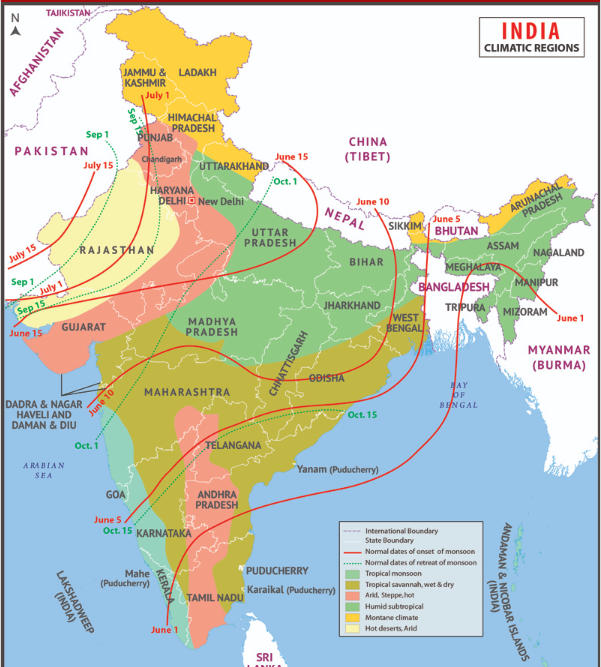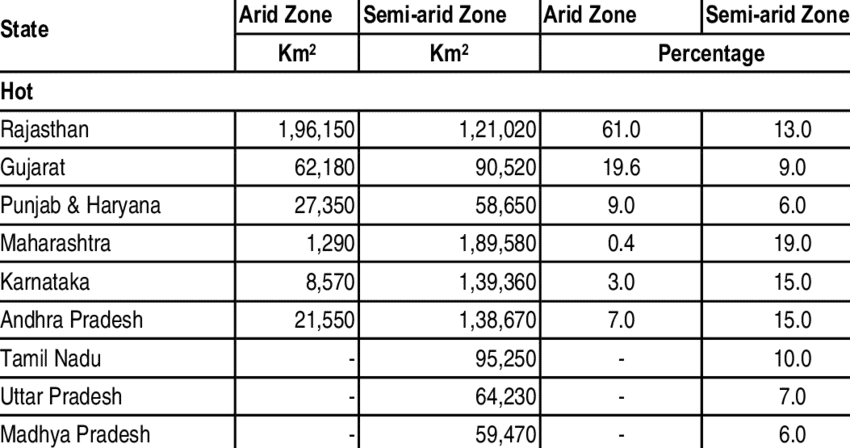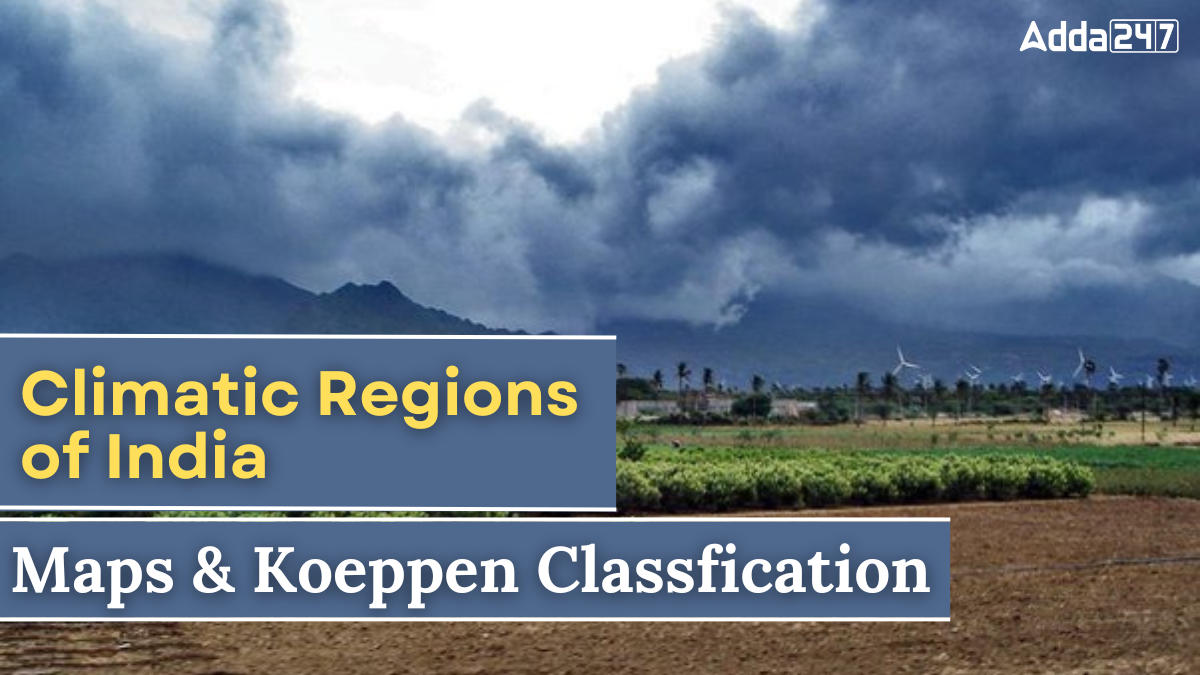Table of Contents
If you are an aspirant of UPSC then you know very well how important geography is for you and among them Climatic Regions of India is the main topic of geography. in this article, we present you the Climatic Regions of India, the region of climate in India with a map and the Koeppen classification. If you read this article you have no doubt related to the Climatic Regions of India—this article is important for UPSC pre and mains.
Climatic Regions of India
The weather of India falls under the tropical monsoon climate, and the main reason for this is the Himalayan mountain range. Due to the northern location of the Himalayan Mountains, the cold winds coming from Siberia are not able to enter India. This keeps most of India warm. This is why the climate of India is mainly called tropical monsoon. This means that summer and rainy seasons are dominant in India, and these seasons keep changing throughout the year. The Himalayan Mountains protect the climate of India from the cold Siberian influence and keep it warm, making the climate of India tropical and monsoonal.
Map of Climatic Regions of India
The climate of India is a tropical monsoon climate, as it varies throughout the year. The country’s climate is classified into five primary zones: tropical, arid, semi-arid, temperate, and alpine. Most geographers have given more importance to rainfall and high temperatures than to temperature when classifying Indian climate zones, as the variation in rainfall is more pronounced than in temperature. The arid and semi-arid zones found in parts of Rajasthan and Gujarat have low rainfall and scorching heat, resulting in dry desert conditions. In contrast, the alpine zone that covers the Himalayan belt has cold temperatures and heavy snowfall. Temperature and rainfall are two important elements that are considered decisive in all schemes of climate classification.

Types of Climatic Zones of India
The climatic characteristics of India vary depending on the region and to understand this, it has been classified into six primary climatic zones: tropical, wet, arid, semi-arid, temperate, and alpine. The tropical zone has high temperatures and heavy rainfall, the arid zone has low rainfall and scorching heat, the semi-arid zone has moderate temperatures and moderate rainfall, the temperate zone has moderate temperatures and regular rainfall, and the alpine zone has cold temperatures and heavy snowfall. These zones are classified on the basis of temperature and rainfall, which makes the Indian climate diverse.
- Tropical
- Wet
- Arid
- Semi-Arid
- Temperate
- Alpine
Tropical
India’s tropical climate is characterized by consistently high temperatures and significant humidity. It often has distinct wet and dry seasons, with heavy rainfall during the wet season. The tropical climate zone in India is the southern region of India, including states such as Karnataka, Tamil Nadu, Kerala, Andhra Pradesh, and the coastal region of Maharashtra. This climate is also found in the Andaman and Nicobar Islands and Lakshadweep. These regions have lush vegetation, diverse ecosystems, and are sensitive to monsoons, which play an important role in agriculture and water resources.
Wet
Wet climate is known from places with tropical humid climate and is also called rainforest. The tropical wet zone of India comprises two major island territories: the Andaman and Nicobar Islands and Lakshadweep. These regions have high moisture levels, which help maintain forests and vegetation throughout the year. Most of the seasonal rainfall occurs between May and November, which plays an important role in maintaining the overall wet conditions of the region.
Arid
The region of India where rainfall is very little or no, as a result of which vegetation is little or sparse, agriculture is difficult or ineffective and human living conditions are precarious. This region is Andhra Pradesh, Gujarat, Haryana, Karnataka, Maharashtra, Punjab and Rajasthan in India
Semi-Arid
A semi-arid climate, also called a semi-desert or steppe climate, is a type of dry climate. Areas with this climate receive less precipitation than potential evapotranspiration, but the amount is greater than in a completely desert climate.

Temperate
Temperate climates are characterized by a variety of climates, with temperatures ranging from hot to cold, and on average, fairly even. Temperate climates support rich soil conditions conducive to a variety of crops and plant life, making these regions agriculturally productive and ecologically diverse.
Alpine
Alpine climates are characterized by cold temperatures, strong winds, and a short growing season. This climate is typically found in mountainous regions. This climate has long, harsh winters with heavy snowfall and short, cool summers. Vegetation is limited to hardy grasses, shrubs, and alpine flowers adapted to the extreme conditions. This climate type is common in high-altitude regions such as the Alps, Rockies, and Himalayas.
Also read- Latitudes, Longitudes
Koeppen Climate Classification
The Koeppen climate classification is a widely adopted system used to classify climates around the world. The Köppen climate classification was first developed by German botanist and climatologist Wladimir Köppen in the late 19th century. It was revised several times after its development. The system studied vegetation, temperature, and precipitation data to designate climate zones. Köppen and other scientists devised a method to define climate zones based on these elements. The system is still in use today and is considered important in the study of weather and environmental research in various regions. It includes five major climate types: tropical, Dry, Mild, Continental, and Polar.
Tropical Climates:
- Wet (Rainforest): Characterized by consistently high rainfall throughout the year.
- Monsoon: Marked by a seasonal shift in winds, leading to heavy rains during the wet season.
- Wet and Dry (Savanna): Features distinct wet and dry seasons, with significant rainfall in the wet season.
Dry Climates:
- Arid: Extremely low precipitation, resulting in deserts.
- Semiarid: Slightly more precipitation than arid regions, often found on the edges of deserts.
Mild Climates:
- Mediterranean: Warm, dry summers and mild, wet winters.
- Humid Subtropical: Hot, humid summers and mild winters with consistent precipitation.
- Marine: Mild temperatures year-round with high humidity and frequent rainfall.
Continental Climates:
- Warm Summer: Warm summers and cold winters with moderate precipitation.
- Cool Summer: Cooler summers and long, cold winters with considerable snowfall.
- Subarctic (Boreal): Very cold winters, short and cool summers, with low precipitation.
Polar Climates:
- Tundra: Extremely cold winters, cool summers, and minimal precipitation, mostly as snow.
- Ice Cap: Perpetually covered in ice and snow, with extremely cold temperatures year-round.




 TSPSC Group 1 Question Paper 2024, Downl...
TSPSC Group 1 Question Paper 2024, Downl...
 TSPSC Group 1 Answer key 2024 Out, Downl...
TSPSC Group 1 Answer key 2024 Out, Downl...
 UPSC Prelims 2024 Question Paper, Downlo...
UPSC Prelims 2024 Question Paper, Downlo...




